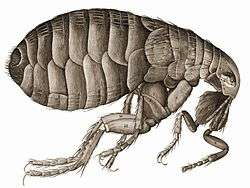蚤
| ||||||||
Translingual
Han character
蚤 (radical 142, 虫+4, 10 strokes, cangjie input 水戈中一戈 (EILMI), four-corner 17136, composition ⿱㕚虫(TJKV) or ⿱叉虫(G))
References
- KangXi: page 1078, character 20
- Dai Kanwa Jiten: character 32893
- Dae Jaweon: page 1547, character 19
- Hanyu Da Zidian: volume 4, page 2836, character 3
- Unihan data for U+86A4
Chinese
| trad. | 蚤 | |
|---|---|---|
| simp. # | 蚤 | |
Glyph origin
| Historical forms of the character 蚤 | ||
|---|---|---|
| Warring States | Shuowen Jiezi (compiled in Han) | Liushutong (compiled in Ming) |
| Chu Slip and silk script | Small seal script | Transcribed ancient scripts |
 |
 |
 |
| Characters in the same phonetic series (蚤) (Zhengzhang, 2003) | |
|---|---|
| Old Chinese | |
| 蚤 | *ʔsuːʔ |
| 慅 | *sʰuːʔ, *suː |
| 騷 | *suː |
| 搔 | *suː |
| 鰠 | *suː |
| 溞 | *suː |
| 颾 | *suː |
| 瘙 | *suːs |
| 瑵 | *ʔsruːʔ |
| 糔 | *suʔ |
| 鼜 | *sʰɯːwɢ |
Ideogrammic compound (會意) : 虫 (“insect”) + 㕚 (“claw”) – a scratching insect/pest.
Pronunciation
Synonyms
| Dialectal synonyms of 跳蚤 (“flea”) [map] | ||
|---|---|---|
| Variety | Location | Words |
| Classical Chinese | 蚤 | |
| Formal (Written Standard Chinese) | 跳蚤 | |
| Mandarin | Beijing | 虼子, 跳蚤 |
| Taiwan | 跳蚤 | |
| Jinan | 虼蚤 | |
| Xi'an | 虼蚤 | |
| Wuhan | 虼蚤 | |
| Chengdu | 虼蚤 | |
| Yangzhou | 虼蚤 | |
| Hefei | 虼蚤 | |
| Cantonese | Guangzhou | 狗蝨 |
| Hong Kong | 狗蝨 | |
| Taishan | 狗蝨 | |
| Yangjiang | 狗蝨 | |
| Gan | Nanchang | 虼蚤 |
| Hakka | Meixian | 狗蝨 |
| Miaoli (N. Sixian) | 跳蚤 | |
| Liudui (S. Sixian) | 跳蚤 | |
| Hsinchu (Hailu) | 跳蚤 | |
| Dongshi (Dabu) | 跳蚤 | |
| Hsinchu (Raoping) | 跳蚤 | |
| Yunlin (Zhao'an) | 蝨嫲 | |
| Jin | Taiyuan | 圪蚤 |
| Min Bei | Jian'ou | 狗蚤 |
| Min Dong | Fuzhou | 虼蚤 |
| Min Nan | Xiamen | 虼蚤 |
| Quanzhou | 虼蚤 | |
| Zhangzhou | 虼蚤 | |
| Taipei | 虼蚤 | |
| Kaohsiung | 虼蚤 | |
| Chaozhou | 虼蚤 | |
| Wu | Suzhou | 跳蝨 |
| Wenzhou | 跳蚤, 蚤 | |
| Xiang | Changsha | 虼蚤, 狗蝨 |
| Shuangfeng | 狗子 | |
Japanese
Etymology

蚤 (nomi): an illustration of a flea.
| Kanji in this term |
|---|
| 蚤 |
| のみ Hyōgaiji |
| kun’yomi |
Possibly derived from 飲み (nomi), the nominalized 連用形 (ren'yōkei, “continuative or stem form”) of verb 飲む (nomu, “to drink”), from the way that fleas drink the host's blood.
Usage notes
As with many terms that name organisms, this term is often spelled in katakana, especially in biological contexts, as ノミ.
Derived terms
Derived terms
- 蚤の市 (nomi no ichi): a flea market
Idioms
Idioms
- 蚤が茶臼 (nomi ga chausu): “[like] a flea [carrying] a tea mortar” → a metaphor for an unreasonable or infeasible hope
Korean
Hanja
蚤 • (jo) (hangeul 조, revised jo, McCune–Reischauer cho, Yale co)
- This term needs a translation to English. Please help out and add a translation, then remove the text
{{rfdef}}.
Okinawan
Pronunciation
- IPA(key): /numi/
Vietnamese
Han character
蚤 (tao)
- This term needs a translation to English. Please help out and add a translation, then remove the text
{{rfdef}}.
This article is issued from
Wiktionary.
The text is licensed under Creative
Commons - Attribution - Sharealike.
Additional terms may apply for the media files.